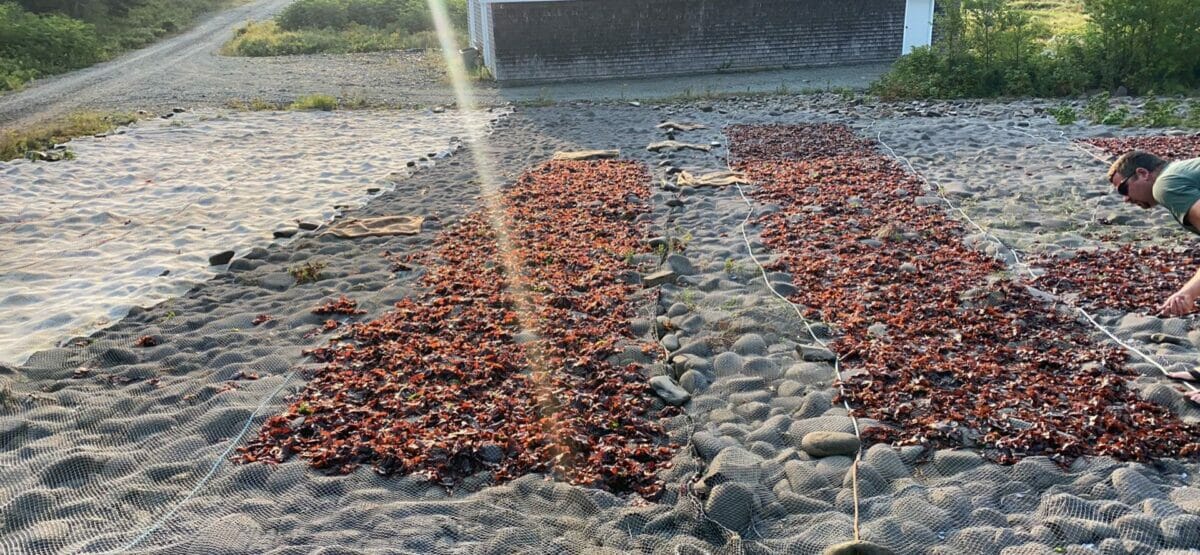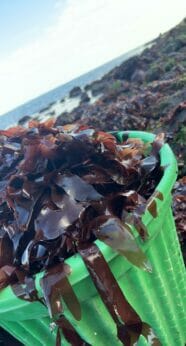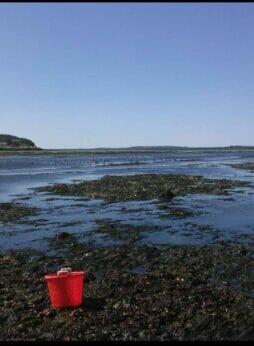A skill passed down through generations, dulsing isn’t what it used to be on New Brunswick’s Grand Manan Island.

It’s low tide and the dories are heading out to sea from New Brunswick’s Grand Manan Island, along Canada’s east coast. Dulsers will spend the next six hours scouring outlying beaches and handpicking the sea vegetable off the exposed ocean floor. This is the way it’s always been done on Grand Manan.
With a population of approximately 2,700, almost everyone on the island has dulsed. Your parents or grandparents were dulsers, you’ve harvested or you know someone who does. It’s one of the Island’s identifiers. But there have been changes recently. “There are good years and bad,” says Bonnie Morse, mayor of Grand Manan. “Dulse isn’t as reliable as it once was.”

Photography courtesy of Noah Leonard.
Located at the entrance of the Bay of Fundy, the island of Grand Manan is a 90-minute ferry ride from New Brunswick’s mainland. Everything on the tiny 24-kilometre-long enclave depends on the sea. In bad weather, the ferry doesn’t come. When the water is calm, tourists arrive to marvel at panoramic ocean views and tiny hamlets where, like in the old days, no one locks their door at night. It creates a protectiveness in islanders towards what the sea provides — especially the dulse. There’s also lobster, herring, scallops and crab to supply Grand Mananers with a steady ocean diet.
Most people outside of Canada’s maritime provinces have never heard of or tasted dulse, the chewy, umami-tasting purple seaweed with an ocean smell. A 21st-century superfood, dulse contains high concentrations of iodine and is loaded with vitamins B, C and A, potassium and calcium. The purity and quality of Grand Manan dulse is sought after by nutraceutical and vitamin manufacturers. On Grand Manan, dulse is added to chowders, stews and pretty much everything in between. Growing in the lower intertidal zones of the North Pacific and Atlantic oceans, it’s one of the world’s oldest foods. Monks on Scotland’s Island of Iona ate it 1,400 years ago. In Iceland, it’s called söl and is a source of dietary fibre. But ask any self-respecting Grand Mananer and they’ll say their dulse is the world’s best. Matthew Abbott of the Conservation Council of New Brunswick credits the tide. “It gives dulse its Grand Manan edge.”
Bay of Fundy tides are the strongest in the world. At peak flood, the water rushing past Grand Manan is 25 million cubic meters per second. The sheer force churns up the seabed, feeding the dulse a steady diet of minerals and nutrients. At low tide on the west side of the island, 200-foot cliffs cast shadows that shade the dulse from the sun and bleach out all that tidal goodness. They’ve been dulse’s secret ingredient — until now.
Typically harvested between June and October, dulse is a finicky crop. It needs a water temperature of between 5 and 14 degrees Celsius to reproduce. The Bay of Fundy averages between 5 and 12 Celsius. But for how long? Climate change is not only heating the atmosphere but the ocean. In 2021, temperatures in the Bay of Fundy were 2.3 degrees above average. “It’s terribly unfortunate,” says Abbot. “It’s the fastest-warming water on the planet.”
But it’s the rock rollers, as Grand Mananers call them, that really do damage. Violent storms cause the sea to overturn the rocks into which the dulse is suckered and ripped to shreds. Climate change has altered weather patterns and once-in-a-decade storms are seemingly yearly now. The slow-growing dulse can’t recover between volleys.
Abbot’s job is to look for ways to protect the shoreline from the ocean’s powerful churn. “There are environmental impact studies and research to be done, but artificial reefs anchoring the dulse in place and preventing a rock roller from doing harm is one idea.”
Atlantic Mariculture, a Grand Manan company that provides dulsers with a market for their haul, is also looking for solutions. Jay J. Botes, marketing and communications lead for the company, says that if the natural environment was too inhospitable for dulse, they may be able to grow it indoors. “I would expect to see dulse being cultivated in land tanks that could mimic the conditions of the wild.”
As conditions change along Grand Manan, Atlantic Mariculture has had to diversify its product line. Popular sea vegetables such as rockweed and nori also cling to Grand Manan’s shores. They are slightly less dependent upon location and water temperature, giving the company a more dependable crop and opportunity for harvesters.

Photography courtesy of Noah Leonard
Grand Mananers have been through this type of decline before. The herring industry used to employ Grand Mananers, says Morse, but when it declined, it was lobster and dulse that anchored people.
“People stayed. They built a life, had children and retired on dulse,” says Morse. “This generation doesn’t see dulsing as a viable career. They’re turning to the mainland for jobs or the more lucrative lobster fishery. They harvest now to supplement other income.”
Morse hopes this will be a good year for dulse. There weren’t rock rollers this winter and the water is cold. The dories still come and go from Grand Manan. But for how long?